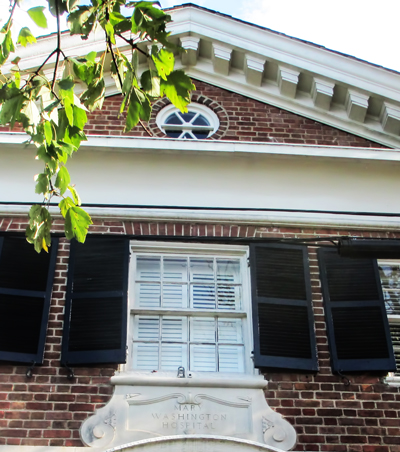
The first Mary Washington Hospital on the corner of Sophia and Fauquier in Fredericksburg was dedicated in Oct. 1899 after almost 3 years of planning meetings, organization and fundraising. Churches played a major role in the creation of the hospital by canvassing for donations. The committee was appointed by 8 churches which encompassed Protestant, Catholic churches and the Jewish synagogue.
Hospitals at the time were not prevalent community organizations. Originally, they were a last-ditch effort for the severely ill. Most of those in the 19th century were charity institutions to provide care for the poor and needy. However, by the 1880’s several hospitals were established through the work of women – Petersburg (1886), Lynchburg (1886) Roanoke (1888), Staunton (1892).
The role of women in creating hospitals would also be a part of the Fredericksburg experience. They formulated policies for what became the Board, did most of the fund raising, supervised plans for the building including awarding its contract. They dominated the Association at the time of the laying of the cornerstone.
The key players from St. George’s were William Seymour White, Mrs. C. E. Tankard, Miss Parker Herndon and the Rev. W. D. Smith. Smith gave the address at the dedication of the Hospital on Oct. 8, 1899 and served on the committee to develop a charter for the hospital. Parker Herndon was only 26 when the organizing effort began. She died early in life at age 36 in 1907. There are newspaper records of her participating in St. George’s programs in 1883.
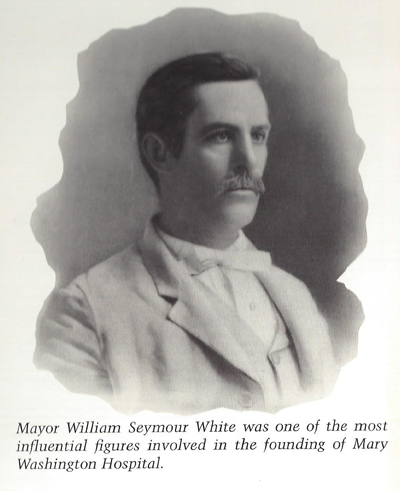
No doubt the leader in the effort was St. Georgian, Seymour White, as he was known. White was a man of many talents and could be considered a Renaissance Man. He had been the editor of the Free Lance and at the time of his death in 1897 at only 44 years of age was the editor of the Daily Star. He was president of the state press association. He was a teacher early in life (teaching St. George’s future rector, the Rev. W. D . Smith ) before reading for the law under John Goolrick. He followed the legal path by becoming Commonwealth Attorney in Stafford. In 1896, he became mayor of Fredericksburg rounding out a career of public service.
White contributed to the development along Washington Avenue. White, along with several other investors, including Maurice B. Rowe a locally prominent businessman, incorporated the Fredericksburg Development Company. White served as secretary. The company purchased large tracts of land in different quadrants of the town and in the surrounding county – 1000 lots on 178 blocks. The smallest of their landholdings and the tract closest to the center of town was a group of parcels located along the proposed Washington Avenue. The original two lots purchased from the Kenmore farm, Lots 39 and 40, were quickly subdivided into 28 residential lots. The development company bought an additional 80-foot strip of land south of these lots from William Key Howard, then owner of the Kenmore mansion. This strip allowed for the opening of Fauquier Street between Winchester Street and Washington Avenue.
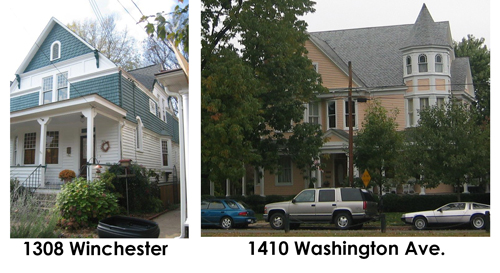
Around 1890, White built a dwelling on the northern end of the avenue at the corner of Washington Avenue and Pitt Street at what is now 1411 Washington Avenue. In 1909, the house was moved to 1308 Winchester Street where it now stands. The picture shows the original location on Washington Avenue and the actual house he built which is now at 1308 Winchester
At the time of his death the Daily Star wrote, “His nature was bright and sunny and nothing pessimistic was ever seen about him.” This was despite the fact he had illnesses early in life that led him to be flat on his back. The Free Lance added to his Renaissance man image. “In journalism he was brilliant. In friendship he was true. As a public official he was faithful.”
The movement to create a hospital began in earnest in early 1897 and continued until opening day. Seymour is the one who provided the name for the organization and led the early effort along with his wife. The impetus for fund raising came just after the completion of the Mary Washington Monument effort in 1894. Seymour was closely involved even to the extent of entertaining President Cleveland in his home. The amount of women involvement was helped by White who notice the energy of women in fundraising for the monument.
The first meeting to organize the hospital was held Jan 15, 1897. It was held at the home of Methodist Mason Tankard. Others from St. George’s included Mrs. W. Seymour White, Mrs. John F. Scott, Mrs. H. Hoomes Johnson. Joining them were 3 ministers (Rev. W. D. Smith from St. George’s, Rev. S. G. Ferguson Methodist, Rev. B. W. Mebane Presbyterian), J. N. Barney, educator, Dr. T. R. Sampson, president of the Fredericksburg Collegiate Institute, and Mayor White.
How was it to be financed? As an agency of the City or charity organization with contributions from the public. The latter prevailed despite a contrary editorial by the Free Lance.
The work was separated into two committees which met Jan 19, 1897. There was a committee appointed to draft a plan or organization with a meeting which started in the mayor’s office and then overflowed to the Renwick Courthouse. White was the chair. A plan was adopted which include the following points.
- The Name would be “Mary Washington Hospital”
- Managed by Board of Regents consisting only ladies elected annually
- Any person contributing $50 annually could name a regent for each amount given
A committee consisting of Revs. Smith and Ferguson and Mayor White would incorporate this work into a charter which would be submitted to the Circuit Court.
A canvassing committee appointed 2 ladies from each church congregation and from any other organization for benevolent and charitable purposes. From St. George’s it was Mrs. White, Parker Herndon and Mrs. C. E. Tankard
There were several meetings in February to hammer out the organization which would be called the Association:
- The government body would be 15 lady managers (later increased to 24) and advisory board of 7 men
- Lady managers elected annually by the Association
- The Lady Managers, pick the officers of the association
- People who gave as much as $1 in year shall be members of the association for that year and can vote
Seymour White would become president of the organization
Other ladies who were not managers organized a hospital auxiliary which would organize entertainment to raise funds. This was headed by Mrs. White. This was later merged into the Association.
Another committee would be working on investigating a building. Build or buy? Where?

The clear decision first was not to incur debt in building the hospital but to raise the money for the building and equipment. The Opera House on the corner of Caroline and William Street (Commerce Street) was used for different types of entertainment and fundraising
The location was to be in lot on the corner of Sophia and Fauquier street facing the river. (Today it is apartments, Mary Washington Square). The lot was bought for $400 from Charles Hunter. Plans were drawn by George Washington Smith and construction began March 1. The contract was for $1,200 to be constructed by Elmer “Peck” Heflin, a construction contractor along with Philip Stearns, preeminent builder of Fredericksburg
The cornerstone was laid on April 14, 1899. This was the anniversary of the date in 1789 of George Washington’s last visit to Fredericksburg to tell his mother he had been elected to the presidency. Part of the first Mary Washington monument, unfinished in 1838 and not completed until the 1890’s was used as a cornerstone.
Silvanus Quinn in his 1908 history of Fredericksburg described the hospital
“The house faces the east and is a modest structure, with a porch in front and an extension on the west end. Two rooms open upon the entrance hall, one of which is the operating room, the other the especial room for a single patient. Back of this is a hall, running north and south, beyond which is the kitchen, matron’s room, bath-room, and store rooms; cellar beneath for wood and such articles as can be kept there. In the extensions are respectively the two large, well-lighted and ventilated rooms for the men’s and women’s wards.”
A special “Donation Day” was held on Sept 29, 1999 since the Board had puts its money in buying the lot and funding the construction. The town helped furnish the equipment and furnishings for the almost completed hospital.
The dedication service was on Oct. 8, 1999. St. George’s rector W. D. Smith “gave the ladies credit for the good work they had accomplished in establishing the hospital and thanked them in the name of the community.”
The featured image of this story is from the original hospital:
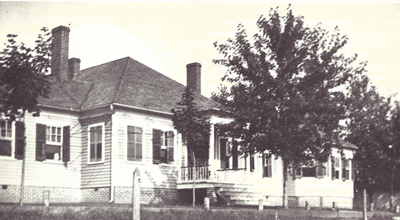
A second story addition that was shown on many postcards was made possible in May, 1910 by a gift from Mrs. Charles Steele (Nannie Gordon French of NY) in memory of her father Seth Barton French. French (1832-1910) was the daughter of Elizabeth Mercer Thornton Barton and Dr. William French. Elizabeth Barton was a daughter of Seth Barton, Revolutionary War veteran who is buried in the St. George’s graveyard.
From a postcard after the second story addition:
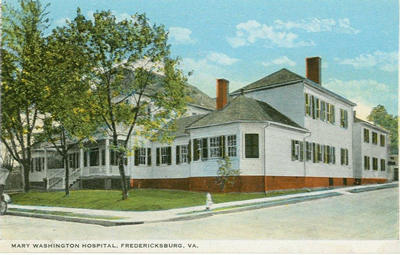
Today’s view of the hospital property – right and left side from across Sophia Street:
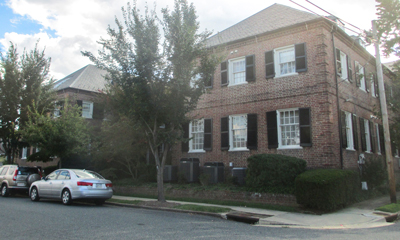

Thanks to Beth Daly for supplying the pictures of the home and home location of Seymour White and the postcard of the 2nd story enlargement of the hospital, all of which came from the Central Rappahannock Heritage Center.
